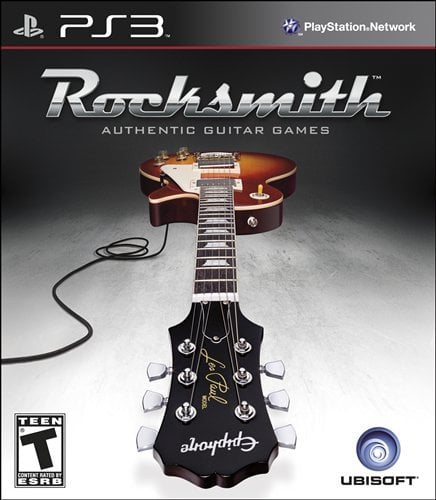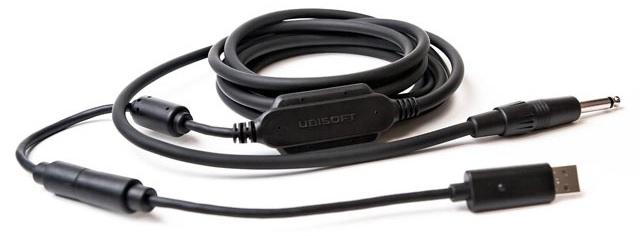Do not “fret” about the boards, chords, or other six-string elements. All ages and skills should take the leap for some practical music knowledge with this impressive guitar music game strengthened by a large song list, great sound, split screen multiplayer mode, and appealing “go-at-your-own-pace” format. Just use any electric guitar with a 1/4″ jack and use the included “real tone cable”.
The Hype
Introducing the next stage in the evolution of the music game. Rocksmith, the first and only game where you plug into any real guitar. Nothing plastic. Nothing fake. Just an authentic guitar experience. By plugging into your console, you’ll develop real skills and styles while playing absolutely real music. Featuring gameplay that automatically adjusts to your personal ability and innovative game design that makes reading music visually intuitive, Rocksmith will engage experienced musicians as well as those who have never picked up a guitar in their life. Nothing compares to playing a real guitar. Except playing Rocksmith.
- When we say any guitar we mean any guitar.
- Whether it’s the guitar sitting in your attic, your cherished faithful steed, or the guitar you have yet to buy, Rocksmith lets you plug any guitar into your Xbox 360 or PlayStation®3 system. As long as your guitar has a jack, you can play. No jack on your guitar? Head down to your local music store, get an inexpensive pickup, and problem solved…Difficulty settings that adapt to your ability.
- You love a challenge, but hate being overwhelmed. Rocksmith understands this, and knows exactly how far to push to keep you entertained and addicted. With dozens of difficulty levels, you will automatically progress from single notes to complex chords without getting in over your head…Lots of music. Lots of styles.
- One of the most satisfying moments for any guitar player is hearing yourself play your favorite song for the first time. Rocksmith has amassed an amazing library of songs from different music genres allowing players to experience that moment first hand…Play songs instead of just learning them.
- You want to play new songs, but you don’t want to labor through tablature or cringe through poorly produced videos. No problem. Rocksmith will not only present you with new songs, but will also challenge you to step away from the notes on screen and play songs by memory. Imagine that. A video game that’ll get you stage-ready….Includes 1/4 Inch to USB Cable.
The Reality
My best guitar playing memory is when my brother and I switched between drums and guitar on “No Sleep ‘Til Brooklyn” by the Beastie Boys with the authentic Bullet Boys guitar pick I caught at one of their concerts in 1989. Patience and practice paid off as our improved play eventually got good enough for more public performance among family and friends. These traits also pay off in UbiSoft’s new music video game Rocksmith, the commercial version of the Guitar Rising educational music video game developed by GameTank.
Players can take a deeper leap in the actual guitar world with a fun, educational experience using only 10MB of hard drive space without the outlandish characters, environments, and limiting guitar peripheral.
The gameplay uses a real electric guitar…any guitar, which transfers into the game as an on-screen fretboard that scrolls from right to left, which provides some continuity from the Guitar Hero and Rock Band game series.
The camera works well by panning and zooming each vital guitar section showing player progression. The guitar strings are color coded red, yellow, blue, orange, green, and purple and the game included reference stickers for the guitar side (a.k.a. neck).
The impressive sound, an essential music game element, shines brightly in the game introduction. Players choose options like the guitar headstock while the in-game manual helps reduce the initial learning time. Players connect the ¼ inch audio jack end of the “real tone cable” into the guitar and the USB end into the PlayStation 3 console. Be sure to use the TV, external speaker system or headphones for the audio cable (red and white).
After finalizing the all-important sound options, player performance centers on matching the original guitar song audio. Tutorial materials include helpful videos then progress to the all-important practice sessions. These sessions alone warrant a game purchase for players wanting to learn real guitar skills.
No distracting breaks or noises when making mistakes. Players just hear the mistake, which matches perfectly with the game’s intentions. Besides reading the music notes and knowing how to play the notes, producing the right tone from the guitar is the key element.
The game difficulty system locks players into skill progression ranging from beginner to intermediate while adding different challenges each time players perform a song, even if it is the same song. Players cannot change the difficulty setting for each song.
Recommendations or open ended choices are always available. Simple string strums and learning chords lead into tough riffs and showcase solos. The progression satisfies and grows throughout the game producing some nice accomplishment. The game feedback and grading system (basically good or bad) provides unique satisfaction. Players get what they put into it and can create a great music legacy that transfers to real life. The crowd graphics and individual animations provide important feedback. People in the crowd also respond with their cell phones.
Song difficulty increases along with player scores. Players also earn certain certification levels for the right to play shows or “gigs”. Progressing play also unlocks music song lists, effects pedals, amps, and different guitars with different tones.
The various game modes includes several main modes as well as the “Guitarcade” mini games that have intuitive shooters, sports, “echoers”, puzzle, and, of course, zombie killing where players lay waste to the undead invaders by playing the correct chord. The Galaga-inspired Ducks mini game works best for beginners since players only have to concentrate on one string while Scale Runner is a great advanced game for learning scale patterns.
The technique challenges mode troubleshoots player performance and offers unlockable techniques like power chords. Again, players can rely on helpful videos on specific techniques then practice them for real. Players can also progress through “Journey” mode for more unlockable items as well. In the experimentation-style amp mode, players change audio settings and unlock effect items for more unique sounds. In the practice mode, players rehearse or progress their guitar playing at their own pace. Players can repeat difficult sections, play certain sections slower, or try one note at a time.
The split screen multiplayer lets another guitar player get into the game (additional cable and guitar required) while advanced players can vie for supremacy on the online leaderboards .
Songs include “Song 2” by Blur; “Sunshine of Your Love” by Cream; “Take Me Out” by Franz Ferdinand; “Use Somebody” by Kings of Leon; “Are You Gonna Go My Way” by Lenny Kravitz, “In Bloom” by Nirvana; “High and Dry” by Radiohead; “Higher Ground” by Red Hot Chili Peppers; “(I Can’t Get No) Satisfaction” by The Rolling Stones; “Panic Switch” by Silversun Pickups; “Slither” by Velvet Revolver; and “Icky Thump” by The White Stripes. Pre-ordered game copies included “Bodysnatchers” by Radiohead and “Free Bird” by Lynyrd Skynyrd (both also available in the download store on PlayStation Network).
Six additional unlockable songs in journey mode appear when players get double encores and downloadable songs appear almost every week and have included song packs by Megadeth and The Black Keys plus a complimentary holiday packs. Each song is available for individual purchase for $2.99 on the PlayStation network or for 240 Microsoft points on Xbox Live. Future downloads will include support for an electric bass, so look for continuing download releases in the near future.
Other fad music games cannot provide the satisfaction in this game, but players must convince themselves to take the worthwhile leap. Hopefully Rocksmith starts a new, long-standing gaming trend with future installments and includes a future option where players can upload their own songs.
Rocksmith is scheduled to release for Windows on May 31, 2012. Cannot find a guitar or want a new one to show off new skills? Rocksmith is currently available on PlayStation 3 and Xbox 360 as a special bundle that includes an Epiphone Les Paul Junior electric guitar along with the game, real tone cable, strap, and two guitar picks.
Review: Rocksmith
Where to Buy: Amazon and other stores
Price: $79.99 and lower (currently at $59.99 on Amazon)
What I Like: players can use any electric guitar for a game controller, play and learn at own pace, mini-games, split screen multiplayer mode, engaging beginner tutorials, and hardware functionality/responsiveness.
What Needs Improvement: special feedback from famous musicians, no online play
Source: Copy provided by publisher



